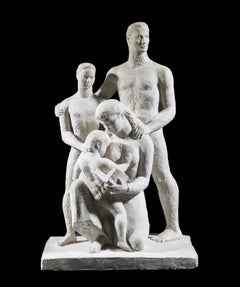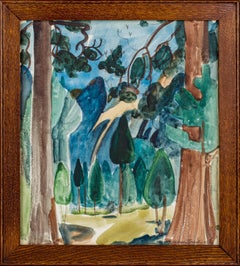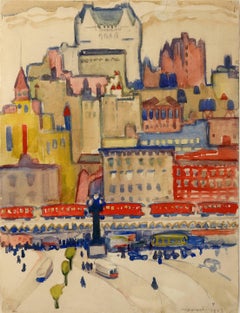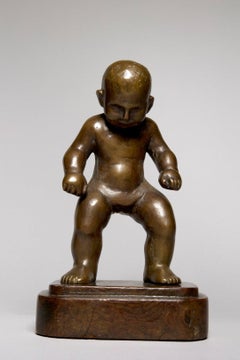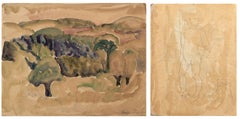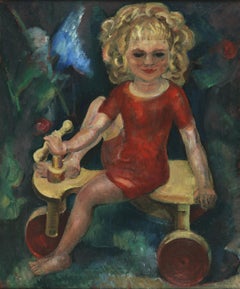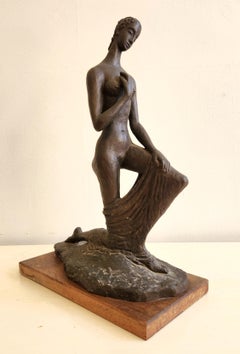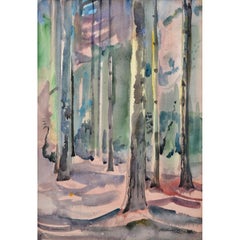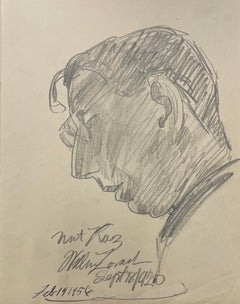William Zorach Art
American, 1887-1966
Born in 1887, by 1930, he was one of America’s premier 20th century sculptors and was honored with multiple commissions and exhibitions including at the Art Institute of Chicago, the Dallas Museum of Fine Art, the Whitney Museum of American Art, and numerous others.
He studied in New York City at the National Academy of Design and also in Paris under the mentoring of Jacques-Emile Blanche. It was in Paris in the first decade of the 20th century where Zorach’s path crossed with Marguerite, his soon to be wife. Both Marguerite and William were both represented in the landmark Armory Show of 1913.
William continued to paint for the next two decades, but increasingly experimenting with sculpture. By the mid 20’s he was carving significant works in marble and stone. By the early 30’s, he abandoned painting entirely in favor of a new art form, sculpture. I t was in sculpture that Zorach found his true voice as an artist and achieved considerable success. “Sculpture, direct carving, was an expanding universe, a liberation and a natural form of expression to me.” Zorach stated.
Museum Collections:
Amon Carter Museum of American Art
Arizona State University Art Museum
Boca Raton Museum of Art
Butler Institute of American Art
Cleveland Artists Foundation
Colorado Springs Fine Arts Center
Cornish Colony Museum
Dallas Museum of Art
Delaware Art Museum
Edwin a Ulrich Museum of Art
Farnsworth Art Museum
Flint Institute of Arts
Frederick R Weisman Art Museum
Georgia Museum of Art
Herbert F Johnson Museum of Art
Jack S Blanton Museum of Art
LaSalle University Art Museum
Los Angeles County Museum of Art
Lowe Art Museum
Marion Koogler McNay Art Museum
Memorial Art Gallery
Metropolitan Museum of Art, NYC
Middlebury College Museum of Art
Minneapolis Institute of Arts
Mobile Museum of Art
Museum of Fine Art-Boston
Pennsylvania Academy of the Fine Arts
Portland Museum of Art
Smithsonian Museum of Art
The Brooklyn Museum of Art
The Canton Museum of Art
The Columbus Museum of Art-Ohio
The Columbus Museum-Georgia
The Cummer Museum Of Art & Gardens
The Currier Museum of Art
The Nelson-Atkins Museum of Art
The Newark Museum
The Phillips Collection
The Phillips Museum of Art
The University of Michigan Museum of Art
Whitney Museum of American Art
Worcester Art Museum
Yosemite Museum
to
5
2
Overall Width
to
Overall Height
to
7
2
3
1
2
1
1
2
2
6
4
3
3
2
2
2
1
1
1
1
1
1
1
1
1
1
1
4
3
2
2
1
8
7,786
4,999
2,504
1,372
2
1
7
Artist: William Zorach
"Pioneer Family" WPA American Modernism Plaster Maquette Realism 20th Century
By William Zorach
Located in New York, NY
"Pioneer Family," 23 1/2 x 16 1/4 x 10 3/4 inPlaster. c. 1927. Unsigned. Realism
The Smithsonian has a cast of this sculpture in its collection. Pictured on the cover of “The Sculpt...
Category
1920s American Modern William Zorach Art
Materials
Plaster
Watercolor Painting by William Zorach, Titled "Redwoods, Yosemite Valley", 1920
By William Zorach
Located in New York, NY
William Zorach, 1887-1966
Redwoods, Yosemite Valley, 1920
Watercolor and pencil
15 ¾ x 13 ⅜ inches
Signed (at lower right): William Zorach
WZorach-7
Provenance:
Estate of William Zorach
Exhibited:
William Zorach, 1887-1996, Sculpture, Drawings and Watercolors, Zabriskie Gallery, New
York; Feb. 10 – March 14, 1998.
William Zorach was born in Lithuania in 1889, and immigrated to the United States with his
family in 1893. Settling in Cleveland with his parents, he worked as a lithographer from 1902-
1908, making enough money to study painting with Henry G. Keller at the School of Art. In
1910, Zorach traveled to Paris to study in La Palette, where he was encouraged to develop his
own unique style rather than adhere to traditional teachings. Zorach once said, “I began to be
conscious of the various modern influences that were invading the art world…I was disturbed
and confused, and yet I felt that I was a very young man entering a new age. The forces creating
modern art seemed more alive to me than anything I had known or anything being done in
America.” 1 Together with his wife Marguerite, William Zorach produced a number of Cubist-
style paintings for the American Armory Show of 1913, and the Forum Exhibition in New York
in 1916.
Around 1917, Zorach followed the lead of cubist artist Pablo Picasso and began experimenting
with wood and stone carvings. By 1922, he devoted himself entirely to sculpture, and like
Picasso, became fascinated in “primitive art”—the ritual objects and sculpture pieces of Oceanic,
Native American and African tribes. Zorach’s work developed in its use of block-like forms with
progressive suppression of detail—drawing elements from sources as disparate as the
contemporary cubist and modernist movements, and combining them with forms seen in early
African sculpture. Though the forms of his sculpture were often abstract, Zorach primarily
focused upon a traditional subject matter, producing such well-known sculptures as Young Girl,
now in the Whitney Museum of American Art, and Mother and Child, in the collection of the
Metropolitan Museum of Art. Today, William Zorach is known as one of the earliest and most
influential American artists dedicated to direct carving. Zorach also made an impression as a
teacher and writer, facilitating a major change in the aesthetic philosophy and technique of
sculpture in the United States.
During the summers from 1913 to 1922, Zorach and his wife Marguerite painted...
Category
1920s William Zorach Art
Materials
Watercolor, Pencil
Quebec City, Fauve Landscape
By William Zorach
Located in Miami, FL
Wonderful Fauve Landscape with blocky areas of punchy bold reds and yellows. This was done the same year of the Armory Show in which both William Zor...
Category
Early 20th Century Expressionist William Zorach Art
Materials
Watercolor
First Steps, Early 20th Century Bronze Sculpture, Cleveland School
By William Zorach
Located in Beachwood, OH
William Zorach (American 1891-1966)
First Steps, 1918
Bronze
8.5 x 5 x 4 inches, including base
Born in 1887 in Lithuania, William Zorach immigrated with his family to the United States when he was just four years old, settling in Cleveland, Ohio. Zorach displayed an exceptional artistic talent at a young age and, at the recommendation of his seventh-grade teacher, began studying lithography at night at the Cleveland School of Art. It was not long before he was apprenticing at a lithography company in Cleveland. It was there that he realized he wanted to become an artist - to escape the commercial end of the field in which he was suddenly immersed.
In 1907, Zorach saved enough money to move to New York and study art at the National Academy of Design, where he received several awards for his paintings and drawings. He continued his studies in Paris in 1910 at La Palette. This year abroad would turn out to be quite fruitful because in Paris he was greatly influenced by the Cubist and Fauvist movements and had several paintings exhibited at the Salon d'Automme. This influence and subsequent success fueled his career back in the states where he was honored with his first one-man exhibition. Due to this new-found stability, he married a young woman he met at school in Paris, and they moved to New York and set up a studio. Shortly after, their work was accepted into the famous 1913 Armory Show.
For the next nine years, Zorach continued to think of himself as a painter, although he had already begun to experiment in sculpting. He was experiencing modest success with his painting and was therefore reluctant to abandon it completely. However, he was impelled toward sculpting, and in 1922, he painted his last oil.
Zorach's involvement with sculpture began largely be accident. While he was working on a series of wood-block prints, Zorach suddenly became more interested in the butternut panel than the print and turned the panel into a carved relief. With no formal training as a sculptor, Zorach's first sculptures were of wood and his carving tools were primitive, such as a jack-knife. I n fact, his early works have a certain stylized look, suggesting the influence of various primitive arts such as African and American folk.
Zorach found his sculptural direction by instinct, but was not unaware of what other sculptors were doing, both here and abroad. He soon allied himself with a growing number of modern sculptors who believed in the esthetic necessity of carving their own designs directly in the block of stone or wood rather than modeling them in clay. From the beginning he found a deep satisfaction in the slow and patient process of freeing the image from its imprisoning block, watching the forms emerge and appear.
"The actual resistance of tough material is a wonderful guide," Zorach said in a lecture on direct sculpture in 1930. The sculptor "cannot make changes easily, there is no putting back tomorrow what was cut away today. His senses are constantly alert. If something goes wrong there is the struggle to right the rhythm. And slowly the vision grows as the work progresses." Zorach also found that the material itself had a constantly modifying effect on the artist's vision. The grain of the wood, the markings in the stone, the shape of the log or boulder all set limits and suggested possibilities. He was always sensitive to the characteristic qualities of his material and occasionally let them play a major role in determining his forms. In works such as these, the feel of the original material is preserved in the finished piece and is often heightened by leaving parts of the original surface untouched and other areas roughly marked by the sculptors tools...
Category
1910s William Zorach Art
Materials
Bronze
Woodlands (Double-sided), Impressionist Watercolor on Paper by William Zorach
By William Zorach
Located in Long Island City, NY
William Zorach, Lithuanian (1887 - 1966) - Woodlands (Double-sided), Year: 1913, Medium: Watercolor on Paper, signed and dated in pencil, with Graphite Drawing on verso, Size: 8.5 ...
Category
1910s Impressionist William Zorach Art
Materials
Watercolor
William Zorach Oil on Canvas Painting Titled "Kiddie Kar", Dated 1920
By William Zorach
Located in New York, NY
Kiddie Kar exemplifies the integration of the primitive aesthetic and the depiction of family in William’s work. The primitive aspect of this particular painting is apparent in its d...
Category
1920s William Zorach Art
Materials
Oil
Hen, Gilded Hen in Polished Bronze
By William Zorach
Located in Brookville, NY
This Sculpture "Hen" by William Zorach in polished bronze is numbered 3/6 although according to the artist son, only 4 were ever cast. Executed in 1946, signed on the reverse and nu...
Category
1940s American Modern William Zorach Art
Materials
Bronze
Related Items
French Fauvist Gouache of Sailing Boats in Port Under a Setting Sun.
Located in Cotignac, FR
Watercolour and gouache on paper of sailing boats at a quay side. The painting is signed bottom right but as yet undeciphered and dated 1945. Presented in a patinated wood custom fra...
Category
Mid-20th Century Expressionist William Zorach Art
Materials
Paper, Watercolor, Gouache
H 20.48 in W 22.84 in D 0.6 in
Replica of Wilhelm Lehmbruck's Kneeling Woman
Located in Troy, NY
This sculpture is a small replica of Wilhelm Lehmbuck's Kneeling Woman. The original sculpture is much larger at around 69.5 x 56 x 27", currently at th...
Category
1960s Expressionist William Zorach Art
Materials
Wood, Plaster
French Seated Figure Sketch Drawing of a Pensive Seated Nude in Profile
Located in Cirencester, Gloucestershire
Collection of Nude drawings
book of watercolour nude paintings on artist paper
painting: 12 x 9.5 inches
provenance: private collection, England
condition: very good and sound condition
Category
20th Century Impressionist William Zorach Art
Materials
Watercolor
H 12 in W 9.5 in D 1 in
Window onto the Sea, Original Drawing, Contemporary Landscape, Architecture
Located in AIX-EN-PROVENCE, FR
Work : Original Drawing, Handmade Artwork, Unique Work. The work has been treated with UV-resistant varnish and it is not framed.
Medium : Watercolour, Soft Pastel and Oil based col...
Category
21st Century and Contemporary Impressionist William Zorach Art
Materials
Archival Paper, Color Pencil, Pastel, Watercolor
H 11.82 in W 11.82 in D 0.12 in
"Train Station, " Max Kuehne, Industrial City Scene, American Impressionism
By Max Kuehne
Located in New York, NY
Max Kuehne (1880 - 1968)
Train Station, circa 1910
Watercolor on paper
8 1/4 x 10 1/4 inches
Signed lower right
Provenance:
Private Collection, Illinois
Max Kuehne was born in Halle, Germany on November 7, 1880. During his adolescence the family immigrated to America and settled in Flushing, New York. As a young man, Max was active in rowing events, bicycle racing, swimming and sailing. After experimenting with various occupations, Kuehne decided to study art, which led him to William Merritt Chase's famous school in New York; he was trained by Chase himself, then by Kenneth Hayes Miller. Chase was at the peak of his career, and his portraits were especially in demand. Kuehne would have profited from Chase's invaluable lessons in technique, as well as his inspirational personality. Miller, only four years older than Kuehne, was another of the many artists to benefit from Chase's teachings. Even though Miller still would have been under the spell of Chase upon Kuehne's arrival, he was already experimenting with an aestheticism that went beyond Chase's realism and virtuosity of the brush. Later Miller developed a style dependent upon volumetric figures that recall Italian Renaissance prototypes.
Kuehne moved from Miller to Robert Henri in 1909. Rockwell Kent, who also studied under Chase, Miller, and Henri, expressed what he felt were their respective contributions: "As Chase had taught us to use our eyes, and Henri to enlist our hearts, Miller called on us to use our heads." (Rockwell Kent, It's Me O Lord: The Autobiography of Rockwell Kent. New York: Dodd, Mead and Co., 1955, p. 83). Henri prompted Kuehne to search out the unvarnished realities of urban living; a notable portion of Henri's stylistic formula was incorporated into his work.
Having received such a thorough foundation in art, Kuehne spent a year in Europe's major art museums to study techniques of the old masters. His son Richard named Ernest Lawson as one of Max Kuehne's European traveling companions. In 1911 Kuehne moved to New York where he maintained a studio and painted everyday scenes around him, using the rather Manet-like, dark palette of Henri.
A trip to Gloucester during the following summer engendered a brighter palette. In the words of Gallatin (1924, p. 60), during that summer Kuehne "executed some of his most successful pictures, paintings full of sunlight . . . revealing the fact that he was becoming a colorist of considerable distinction." Kuehne was away in England the year of the Armory Show (1913), where he worked on powerful, painterly seascapes on the rocky shores of Cornwall. Possibly inspired by Henri - who had discovered Madrid in 1900 then took classes there in 1906, 1908 and 1912 - Kuehne visited Spain in 1914; in all, he would spend three years there, maintaining a studio in Granada. He developed his own impressionism and a greater simplicity while in Spain, under the influence of the brilliant Mediterranean light. George Bellows convinced Kuehne to spend the summer of 1919 in Rockport, Maine (near Camden). The influence of Bellows was more than casual; he would have intensified Kuehne's commitment to paint life "in the raw" around him.
After another brief trip to Spain in 1920, Kuehne went to the other Rockport (Cape Ann, Massachusetts) where he was accepted as a member of the vigorous art colony, spearheaded by Aldro T. Hibbard. Rockport's picturesque ambiance fulfilled the needs of an artist-sailor: as a writer in the Gloucester Daily Times explained, "Max Kuehne came to Rockport to paint, but he stayed to sail." The 1920s was a boom decade for Cape Ann, as it was for the rest of the nation. Kuehne's studio in Rockport was formerly occupied by Jonas Lie.
Kuehne spent the summer of 1923 in Paris, where in July, André Breton started a brawl as the curtain went up on a play by his rival Tristan Tzara; the event signified the demise of the Dada movement. Kuehne could not relate to this avant-garde art but was apparently influenced by more traditional painters — the Fauves, Nabis, and painters such as Bonnard. Gallatin perceived a looser handling and more brilliant color in the pictures Kuehne brought back to the States in the fall. In 1926, Kuehne won the First Honorable Mention at the Carnegie Institute, and he re-exhibited there, for example, in 1937 (Before the Wind). Besides painting, Kuehne did sculpture, decorative screens, and furniture work with carved and gilded molding. In addition, he designed and carved his own frames, and John Taylor Adams encouraged Kuehne to execute etchings. Through his talents in all these media he was able to survive the Depression, and during the 1940s and 1950s these activities almost eclipsed his easel painting. In later years, Kuehne's landscapes and still-lifes show the influence of Cézanne and Bonnard, and his style changed radically.
Max Kuehne died in 1968. He exhibited his work at the National Academy of Design, the Art Institute of Chicago, the Carnegie Institute in Pittsburgh, the Memorial Art Gallery of the University of Rochester, and in various New York City galleries. Kuehne's works are in the following public collections: the Detroit Institute of Arts (Marine Headland), the Whitney Museum (Diamond Hill...
Category
1910s American Impressionist William Zorach Art
Materials
Paper, Watercolor
Melody II by Nando Kallweit. Elegant figurative sculpture.
By Nando Kallweit
Located in Coltishall, GB
Melody II is a figurative bronze sculpture in a relaxed pose by Nando Kallweit.
Modelled on modern youthful postures but with a nod to the importance of heritage through the stylise...
Category
21st Century and Contemporary Other Art Style William Zorach Art
Materials
Bronze
H 9.06 in W 2.37 in D 1.19 in
"Zoltan" - 1990 Male Nude Study
By Arnold A. Grossman
Located in Soquel, CA
"Zoltan" - 1990 Male Nude Study
Watercolor painting depicting a nude male figure. The brunette male figure is posing, seated on a purple cloth, his left hand gripping a table net to him, while he leans on his right elbow, his face looking straight ahead. The background is made up of hues of green.
Signed "AG" lower left.
Signed, titled and dated on verso.
"Arnold Grossman, 'Zoltan' November 1990"
Presented in a white mat.
Image with mat: 19"H x 22"W
Image: 10.5"H x 14.5"W
Sheet: 12"H x 16"W
Arnold A...
Category
1990s American Impressionist William Zorach Art
Materials
Paper, Watercolor
Vintage art portrait - FRIED PAL Paris, Ballerina in pink, O/C, signed canvas
Located in PARIS, FR
Conditions : Original canvas with artist stamp.
Fried was born in Budapest and studied at the Hungarian Academy of Professor Pohl Hugo in Paris in the company of Claude Monet and Lu...
Category
Late 19th Century Impressionist William Zorach Art
Materials
Oil
Dance
Located in Zofingen, AG
In this vibrant oil painting, I've unleashed a wave of dynamic energy and emotion. The abstract forms blend with expressionist fervor, as the figures—a synthesis of impressionist and...
Category
2010s Abstract Impressionist William Zorach Art
Materials
Canvas, Oil, Acrylic
Seaside landscape at Quiberon (France), oil on canvas
Located in PARIS, FR
Andre KAUFFER (1893-1971)
Seaside landscape - Quiberon, circa 1940
Oil on canvas
Signed lower left
Located “Quiberon” on the back
23 x 46 cm
Old frame in painted wood
Born in Nancy ...
Category
1940s William Zorach Art
Materials
Oil
Bust of a Man - Sculpture after Aurelio Mistruzzi - 1990s
Located in Roma, IT
Bust of a man is an original sculpture in bronze realized after Aurelio Mistruzzi in the late 1990s.
Bronze casting.
18 cm height, 24 cm height with wooden base.
Good conditions.
Category
1990s Modern William Zorach Art
Materials
Bronze
Escuela Italiana (XVIII) - El martirio de santa Catalina - Óleo sobre cobre
Located in Sant Celoni, ES
La obra no va firmada, es de autor anónimo
El estado de la obra es bueno
Se presenta enmarcada la obra con un marco del siglo xvii en madera estucada y policromada en oro fino
Med...
Category
Early 18th Century Baroque William Zorach Art
Materials
Oil
H 11.82 in W 9.45 in D 1.19 in
Previously Available Items
William Zorach Watercolor Painting, Forest Landscape
By William Zorach
Located in Lake Worth Beach, FL
Artist/Designer; Manufacturer: William Zorach (American, 1887-1966)
Marking(s); notes: signed, marking(s); 1942
Materials: watercolor on paper
Dimensions (H, W, D): 22"h, 15"w; 33"h,...
Category
20th Century William Zorach Art
Materials
Watercolor
PORTRAIT OF NATHANIEL KAZ
By William Zorach
Located in Portland, ME
Zorach, William (American 1887-1966). PORTRAIT OF NATHANIEL KAZ. Pencil on paper, 1956. Inscribed and signed by Zorach as follows: "Nat Kaz / William Zorach / Sept 19 1920 / Feb 19, ...
Category
1950s William Zorach Art
Materials
Graphite
Girl with Clasped Hands
By William Zorach
Located in Fairlawn, OH
Girl with Clasped Hands
Watercolor on paper, 1913
Signed and dated lower right (see photo)
Provenance: Gift of the Artist
Felix ...
Category
1910s American Modern William Zorach Art
Materials
Watercolor
TEN TREES ON A HILL
By William Zorach
Located in Portland, ME
Zorach, William (American, 1887-1966). LANDSCAPE WITH CLOUDS. Watercolor and pencil on paper, not dated, but circa 1913. Unsigned, but inscribed verso "By William Zorach/(Tessim Zorach)." Tessim Zorach, (1915-1995) was the eldest of the children of William and Marguerite Zorach. 8 x 11 1/2 inches, the full sheet. Provenance, Tessim Zorach, Zabriskie Gallery...
Category
1910s William Zorach Art
Materials
Watercolor
LANDSCAPE WITH CLOUDS
By William Zorach
Located in Portland, ME
Zorach, William (American, 1887-1966). LANDSCAPE WITH CLOUDS. Watercolor on paper, 1913. Signed and dated in pencil, lower right. 9 1/2 x 11 inches, the full sheet. Provenance, The a...
Category
1910s William Zorach Art
Materials
Watercolor
"Beach Day"
By William Zorach
Located in Southampton, NY
This is a very early painting by William Zorach done mostly likely when he was a student at the National Academy of Design in 1910 in New York. It is done in an impressionist style w...
Category
Early 1900s American Impressionist William Zorach Art
Materials
Oil, Board
"Study of a Hand, 1934"
By William Zorach
Located in Southampton, NY
This is a very nice drawing of a study of a hand; graphite on paper done by William Zorach in 1934. Pencil signed and dated lower right on the mat. In ...
Category
1930s American Modern William Zorach Art
Materials
Graphite
Winter Day Along the Kennebec
By William Zorach
Located in Wiscasset, ME
Painter, sculptor and writer William Zorach was born in Lithuania in 1889 but moved to the United States with his family in 1893, settling in Cleveland. Zorach stayed in Ohio for al...
Category
1930s Modern William Zorach Art
Materials
Watercolor
Maine Harbor
By William Zorach
Located in Fairlawn, OH
Signed lower right: Zorach
From the Estate of Felix Russman (1888-1962), a friend of Zorach and fellow artist.
Bibliography:
Henry Adams, Out of the Kok...
Category
William Zorach Art
William Zorach art for sale on 1stDibs.
Find a wide variety of authentic William Zorach art available for sale on 1stDibs. You can also browse by medium to find art by William Zorach in paint, watercolor, oil paint and more. Much of the original work by this artist or collective was created during the 20th century and is mostly associated with the modern style. Not every interior allows for large William Zorach art, so small editions measuring 7 inches across are available. Customers who are interested in this artist might also find the work of Walter Beach Humphrey, Stuart Davis, and Jan Matulka. William Zorach art prices can differ depending upon medium, time period and other attributes. On 1stDibs, the price for these items starts at $1,875 and tops out at $45,000, while the average work can sell for $18,000.
